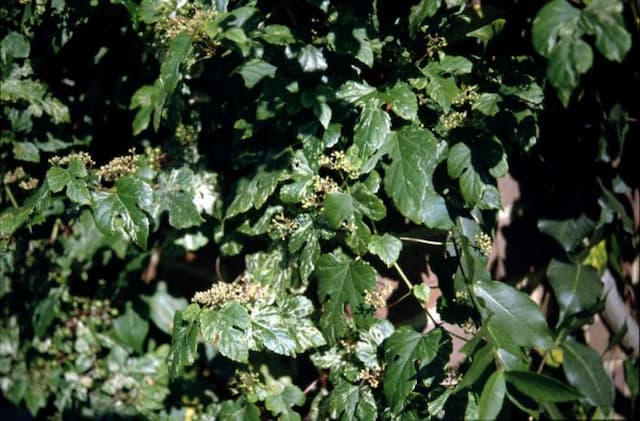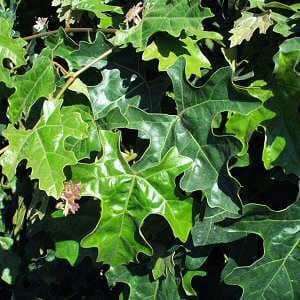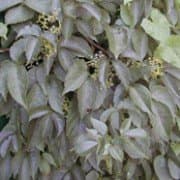Boston Ivy Parthenocissus tricuspidata

ABOUT
The plant commonly known as Boston ivy has a vibrant and lush appearance. It showcases broad leaves that typically consist of three pointed lobes, although some may also exhibit five lobes. The foliage unfurls with a reddish color during the spring, transforms into a verdant green for the summer, and as autumn approaches, it turns into a striking array of reds and purples, offering a stunning display of fall color. Boston ivy is a vigorous climber that uses small adhesive disks on the ends of its tendrils to attach itself securely to surfaces. Its climbing nature allows the plant to create a dense and expansive coverage over structures and features it grows upon, making it a popular choice for covering walls, fences, and trellises. The plant also produces small, inconspicuous flowers that are greenish-white in appearance. These blooms give way to small, bluish-black berries that are attractive to birds, although they are not suitable for human consumption. The bark of the Boston ivy is thin and has a smooth texture, adding a subtle charm to the plant's appearance when visible. Overall, Boston ivy is noted for its dynamic seasonal changes, verdant coverage, and the ability to provide a natural cloak over structures, giving it both an aesthetic and utilitarian appeal.
About this plant
 Names
NamesFamily
Vitaceae.
Synonyms
Boston Ivy, Grape Ivy, Japanese Ivy, Japanese Creeper, Woodbine.
Common names
Ampelopsis hoggii, Ampelopsis tricuspidata, Ampelopsis veitchii, Cissus tricuspidata, Hedera rhombea, Hedera tricuspidata, Parthenocissus argentea, Parthenocissus inserta, Parthenocissus thomsonii, Parthenocissus wilsonii, Psedera tricuspidata, Vitis inserta, Vitis tricuspidata.
 Toxicity
ToxicityTo humans
Boston Ivy, the common name for Parthenocissus tricuspidata, is not considered highly toxic to humans. However, contact with the skin can sometimes cause dermatitis, irritation, or allergic reactions in sensitive individuals. If ingested, parts of the plant, especially the berries, can cause gastrointestinal upset, such as nausea, vomiting, and diarrhea. Although the toxicity is generally low, it is still advisable to avoid ingesting any parts of the plant.
To pets
For pets, Boston Ivy can be more problematic. While it is not known to be highly toxic, the ingestion of the leaves or berries of Boston Ivy can cause vomiting, diarrhea, and abdominal pain in animals such as dogs and cats. The berries are particularly attractive to pets and can cause the most significant symptoms if eaten in large quantities. To avoid any potential health issues, it's best to prevent pets from consuming any parts of the Boston Ivy plant.
 Characteristics
CharacteristicsLife cycle
Perennials
Foliage type
Deciduous
Color of leaves
Green
Height
30 feet (9 meters)
Spread
5-10 feet (1.5-3 meters)
Plant type
Climber
Hardiness zones
4-8
Native area
East Asia
Benefits
 General Benefits
General Benefits- Architectural interest: Parthenocissus tricuspidata, commonly known as Boston Ivy, offers visually appealing coverage for walls, fences, and facades with its lush foliage that changes colors with seasons.
- Erosion control: Its extensive root system helps in stabilizing soil on slopes and prevents erosion.
- Shade provision: When grown on pergolas or trellises, Boston Ivy produces a dense canopy that generates shade, thus contributing to cooler surroundings.
- Wildlife habitat: It provides shelter and nesting sites for various species of birds and small wildlife.
- Aesthetic enhancement: It adds visual appeal to garden designs thanks to the attractive texture and vibrant fall colors of its leaves.
- Privacy screen: Boston Ivy can create a natural privacy barrier when grown on structures, obscuring unwanted views and increasing seclusion.
- Urban greening: As a robust climber, it contributes to greening of urban areas, softening the hard lines of buildings, and integrating nature into cityscapes.
 Medical Properties
Medical PropertiesThis plant is not used for medical purposes.
 Air-purifying Qualities
Air-purifying QualitiesThis plant is not specifically known for air purifying qualities.
 Other Uses
Other Uses- Parthenocissus tricuspidata, also known as Boston ivy, can be utilized in urban areas to mitigate the heat island effect. Its dense foliage can cover buildings, absorbing sunlight and reducing the amount of heat absorbed by structures.
- Boston ivy berries, while not commonly consumed, can be used to make natural dyes for fabrics or artwork, typically providing a range of blue and purple hues.
- The vines of Boston ivy can be crafted into wreaths or other decorative items during the autumn season when the leaves take on a vibrant red color.
- The tendrils of Boston ivy can be used in floral arrangements to add a touch of greenery or can act as a natural binding material for bouquets.
- In landscaping, Boston ivy can be planted to stabilize slopes or banks, as its vigorous roots help prevent soil erosion.
- Boston ivy can be used in theme parks or movie sets to quickly cultivate an appearance of age or neglect on buildings and structures by encouraging the vine to grow over them.
- During fall, the falling leaves of Boston ivy can be collected and used as mulch to improve soil quality and protect plant roots in gardens.
- Aquarists sometimes use dried pieces of Boston ivy wood in aquariums to add natural decor and hideouts for fish; however, they must be cautious as the plant can be toxic if ingested by some animals.
- Boston ivy's rapid growth can be harnessed for creating living green sculptures by training the vines over metal frames or forms.
- For soundproofing, the dense mat of Boston ivy foliage can act as a noise buffer when grown against walls facing busy streets or highways.
Interesting Facts
 Feng Shui
Feng ShuiThe Boston Ivy is not used in Feng Shui practice.
 Zodiac Sign Compitability
Zodiac Sign CompitabilityThe Boston Ivy is not used in astrology practice.
 Plant Symbolism
Plant Symbolism- Growth: Parthenocissus tricuspidata, commonly known as Boston Ivy, is characterized by its vigorous growth habit, symbolizing expansion and unchecked development.
- Protection: Boston Ivy often covers buildings and walls with its dense foliage, symbolizing a natural protective barrier or a shield.
- Adaptability: Due to its ability to thrive in diverse conditions, it symbolizes versatility and resilience.
- Tenacity: With its strong tendrils that cling tightly to surfaces, Boston Ivy represents perseverance and determination.
- Change: The leaves of Boston Ivy change color dramatically with the seasons, representing transformation and adaptability to change.
 Water
WaterBoston Ivy prefers consistent moisture, so it's important to water it regularly while avoiding waterlogged conditions. During the growing season, provide approximately 1 gallon of water per square yard once a week, ensuring the soil is moist but not saturated. In hot, dry periods, increase watering to twice a week. During winter, reduce watering as the plant's water requirements decrease. Always check the soil moisture level before watering to prevent overwatering.
 Light
LightBoston Ivy thrives in full sun to partial shade. It is adaptable to different lighting conditions but prefers bright, indirect light for optimal growth. The best spot for planting Boston Ivy would be a location where it receives at least four hours of direct sunlight each day, though it can tolerate and grow in shadier spots as well.
 Temperature
TemperatureBoston Ivy is hardy and can withstand a range of temperatures. It prefers a temperate climate with temperatures between 60°F and 80°F for ideal growth. The plant can survive winter lows down to -10°F and summer highs up to 90°F or more, making it versatile and resilient.
 Pruning
PruningPrune Boston Ivy to control its size, remove dead or damaged growth, and encourage a fuller, healthier plant. The best time for pruning is late winter or early spring before new growth begins. Prune as needed throughout the growing season to maintain the desired shape and size.
 Cleaning
CleaningAs needed
 Soil
SoilThe Boston ivy thrives in rich, loamy, well-draining soil with a pH of 5.5 to 7.5. A good soil mix could be equal parts garden soil, peat, and perlite or sand to ensure drainage. Adjust pH with lime if too acidic, or sulfur if too alkaline.
 Repotting
RepottingBoston ivy does not require frequent repotting and is often left undisturbed for several years. Repot every 3-5 years or when the plant has outgrown its current pot, preferably in spring.
 Humidity & Misting
Humidity & MistingBoston ivy is quite adaptable but prefers a moderate humidity level. The plant can tolerate some dry air, but aiming for about 40-50% humidity is beneficial for optimal growth.
 Suitable locations
Suitable locationsIndoor
Ensure light; use rich, well-draining soil.
Outdoor
Full sun to part shade; well-draining soil; train on structures.
Hardiness zone
4-8 USDA.
 Life cycle
Life cycleParthenocissus tricuspidata, commonly known as Boston ivy, begins its life cycle as a seed, which, when conditions are right, germinates in spring. The seedling develops into a juvenile vine with simple leaves, and as it matures, it starts to produce the distinct three-pointed, or 'tricuspidata', leaves for which it is named. Throughout the growing season, which is typically spring through early fall, Boston ivy vigorously climbs surfaces using small tendrils with adhesive disks for attachment, growing rapidly in both height and girth. It enters a reproductive phase in late summer, blooming with small, inconspicuous flowers that later develop into small, dark blue berries by autumn. These berries serve as food for birds, which aid in seed dispersal. As a deciduous vine, Boston ivy drops its leaves in response to cooler fall temperatures, entering dormancy in winter before beginning its cycle again the following spring.
 Propogation
PropogationPropogation time
Spring-Early Summer
The most popular method of propagating Boston ivy (Parthenocissus tricuspidata) is through stem cuttings. This method is best performed in late spring or early summer when the plant's growth is most vigorous. To do this, take a stem cutting approximately 6 inches (15 centimeters) long, ensuring there are at least 2-3 nodes present. The bottom cut should be made just below a node, where the concentration of rooting hormones is high. Strip off the lower leaves, and dip the cut end in rooting hormone powder to encourage root growth. Plant the cutting in a pot with moist potting mix, and keep it warm and out of direct sunlight. Roots should begin to form within a few weeks, after which the new plant can eventually be transferred to its permanent location.









![Grape [Claret Cloak]](/_next/image?url=https%3A%2F%2Fplants-admin.emdemapps.com%2Fimages%2Fplants%2F%2Fimages%2F604b602abe2f8.png&w=640&q=75)